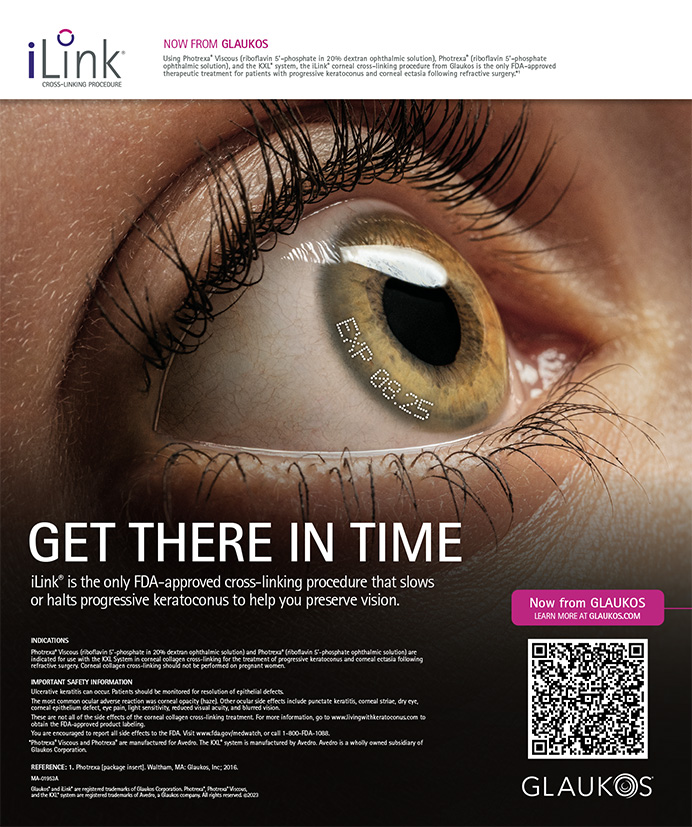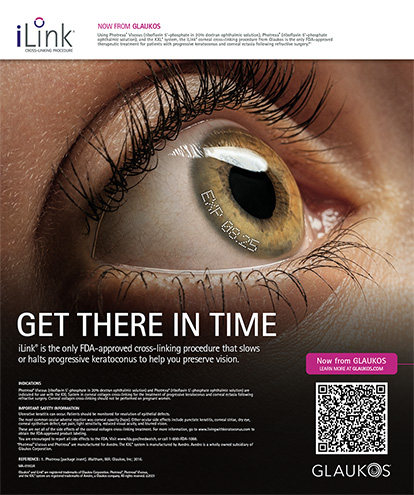Given its high visual morbidity, postoperative endophthalmitis represents one of the most feared complications of intraocular surgery. This condition is most often encountered after cataract extraction, among the most commonly performed operations in the US with approximately 1.5 million procedures annually. The incidence of postoperative endophthalmitis is approximately 0.1% after cataract surgery. This article reviews the pathogenesis, treatment, and prophylaxis of endophthalmitis.
THE EVS
Researchers have studied acute bacterial postoperative endophthalmitis extensively in a randomized, prospective clinical trial known as the Endophthalmitis Vitrectomy Study (EVS).1 Patients with acute postoperative endophthalmitis present with pain, photophobia, floaters, reduced vision, an inflamed anterior segment including a variable hypopyon, and vitritis (Figure 1). In the EVS, the median time to presentation to a study center was on postoperative day 6, and typical organisms included coagulase-negative staphylococci (46.9%), other gram-positive organisms (15.5%), and, much less commonly, gram-negative organisms (4.1%). Culture-negative or culture-equivocal cases were also common in the EVS (17.9% and 12.9%, respectively) and may be due in part to the rightfully strict criteria for laboratory-confirmed growth in this multicenter study.
Until the EVS, the utility of pars plana vitrectomy to potentially decrease the bacterial and toxin load, facilitate intravitreal antibiotic distribution, and clear the media was unknown, as was the need to administer systemic antibiotics in addition to intravitreal antibiotics. In order to address these issues, the EVS investigators enrolled 420 endophthalmitis patients who presented within 6 weeks of cataract extraction or secondary IOL placement. Researchers randomized the subjects in a two-by-two factorial design to pars plana vitrectomy versus vitreous tap and also to intravenous ceftazidime plus amikacin sulfate versus no systemic antibiotics. All patients received intravitreal vancomycin hydrochloride plus amikacin sulfate. The study showed that intravenous antibiotics did not improve the outcome. In addition, in the 74% of subjects who had a visual acuity better than light perception, a pars plana vitrectomy did not improve the outcome.1
MANAGEMENT GUIDELINES
The EVS provides very useful guidelines for the management of acute postoperative endophthalmitis. In particular, if immediate posterior segment consultation is not available, cataract surgeons should not hesitate to perform a vitreous tap and inject patients who present with signs of acute postoperative endophthalmitis and a visual acuity better than light perception. Vancomycin (1.0 mg/0.1 mL) plus amikacin (0.2 to 0.4 mg/0.1 mL) or vancomycin (1.0 mg/0.1 mL) plus ceftazidime (2.0 mg/0.1 mL) can be injected at the pars plana after a vitreous tap; the latter regimen may be preferable, because aminoglycosides can cause retinal necrosis at high levels in cases of dilution error. Patients with a visual acuity of light perception or worse should be promptly referred to a vitreoretinal specialist for consideration of a pars plana vitrectomy. Some clinicians also inject dexamethasone at 0.4 mg/0.1 mL in order to minimize the morbidity of severe ocular inflammation. Some ophthalmologists initiate a course of oral ofloxacin (400 mg b.i.d.) as initial systemic therapy or following a brief course of intravenous therapy, because oral ofloxacin is readily available and well tolerated, has broad coverage (including slightly better coverage for gram-positive organisms than ciprofloxacin), and achieves reasonable intravitreal levels.
PROPHYLAXIS
Targeting Pathogenesis of Postoperative Endophthalmitis
The seriousness of postoperative endophthalmitis has prompted ophthalmic surgeons to adopt a variety of prophylactic techniques. Several studies have supported the notion that the patient's external tissues represent the major source of infection. In the EVS, eyelid isolates were indistinguishable from intraocular isolates in 71 (67.7%) of the available 105 comparisons studied by pulsed-field gel electrophoresis, an established molecular strain-typing technique.2 Multiple studies have suggested that these surface flora routinely enter the anterior chamber during cataract surgery. In one large prospective study of 700 consecutive patients undergoing planned cataract extraction, anterior chamber aspirates were culture-positive in 14.1% of subjects at the beginning and in 13.7% of patients at the end of surgery, with coagulase-negative staphylococci and corynebacteria as the most common organisms.3 Given the results of this and similar studies, it is generally thought that the anterior chamber can clear a low inoculum of bacteria after cataract surgery without developing endophthalmitis. However, the presence of capsular tears that provide communication with the vitreous cavity may compromise the ability of the eye to clear bacteria and may consequently increase the risk of endophthalmitis.
Because surface flora can enter the eye during surgery, ophthalmic surgeons have adopted many prophylactic techniques aimed at suppressing the number of organisms and limiting their growth. These techniques have gained common acceptance by ophthalmic surgeons despite the limited proof of efficacy for many.
Efficacy of Prevention
Endophthalmitis prevention is difficult to investigate because of its infrequent occurrence and the large number of variables associated with even the most routine form of cataract surgery. In particular, there have been no large, multicenter, masked, controlled, and randomized investigations of prophylactic methods.
In a recent evidence-based review of prophylactic techniques for acute bacterial endophthalmitis after cataract surgery, no prophylactic technique received the highest of three possible clinical recommendations (crucial to clinical outcome).4 Only preoperative povidone-iodine preparation received the intermediate clinical recommendation (moderately important to clinical outcome). All other reported prophylactic interventions—including postoperative subconjunctival antibiotic injection, preoperative lash trimming, preoperative saline irrigation, preoperative topical antibiotics, antibiotic-containing irrigating solutions, and the use of intraoperative heparin—received the lowest clinical recommendation (possibly relevant but not definitely related to clinical outcome), based on weak and often conflicting evidence justifying their use. Some of these methods for endophthalmitis prophylaxis could potentially be effective, but they have not been studied in large, randomized, prospective studies with consistent results and, therefore, would not have received high clinical recommendations.
Unfortunately, it is unlikely that such an investigation will occur, largely because endophthalmitis occurs relatively infrequently. A study would require an enormous number of subjects to achieve a statistically meaningful result, a requirement that would make it prohibitively expensive. In addition, such a study would be logistically difficult to administer with its large number of surgeons and study centers. As a result, the researchers conducting this recent evidence-based review of prophylactic techniques concluded that the current literature most strongly supports the use of preoperative povidone-iodine antisepsis for acute bacterial endophthalmitis prophylaxis after cataract surgery, while other prophylactic techniques, if properly studied, may also prove to be effective.4
There are convincing data suggesting that povidone-iodine preparation decreases the conjunctival flora. A masked prospective study in 30 consecutive patients undergoing eye surgery showed that half-strength povidone-iodine (Betadine; Purdue Frederick, Stamford, CT) solution decreased the number of colonies isolated from the conjunctiva by 91% and decreased the number of species by 50%, a statistically significant difference from fellow control eyes.5 Povidone-iodine preparation decreases the conjunctival load of Propinibacterium acnes, a common cause of chronic postoperative endophthalmitis.6,7 One study6 of 488 patients undergoing cataract extraction showed that povidone-iodine solution decreased the incidence of P. acnes isolation from the conjunctiva from 36.7% to 9%.
In another study of 261 patients undergoing intrabulbar surgery, 60 (23%) of 261 conjunctival swabs taken after application of antibiotic eye drops (polymyxin B sulfate, neomycin sulfate, and gramicidin in combination) but prior to povidone-iodine application were positive for P. acnes. Following povidone-iodine treatment, five patients (1.9%) remained culture-positive
(P < .001).7 A similar study by the same group demonstrated a similarly beneficial effect with respect to staphylococci, the most common cause of endophthalmitis.8 From 300 cases, 30.3% of the conjunctival smears were culture-positive for staphylococci after the application of antibiotic eye drops (polymyxin B sulfate, neomycin sulfate, and gramicidin in combination) but prior to povidone-iodine application. After the application of povidone-iodine, 7.7% remained culture-positive for staphylococci, and, at the end of surgery, 5.3% of the patients remained culture-positive. Both results represent a statistically significant reduction compared with preoperative cultures (P<.001).8
Several groups have studied the use of povidone-iodine in a prospective fashion. One group of investigators conducted a large, open-label, nonrandomized parallel trial during an 11-month period in which topical 5% povidone-iodine was applied preoperatively in one set of five ORs, while silver protein solution was applied in another set of five rooms.9 In all cases, the surgeons continued to use their customary prophylactic antibiotics. The povidone-iodine group showed a significantly (P<.03) lower incidence of culture-positive endophthalmitis (two of 3,489 cases, 0.06%) compared with the silver protein group (11 of 4,594 cases, 0.24%). There were no adverse reactions to povidone-iodine.9 A similar trend was noted in a retrospective series of 19,269 consecutive cases of cataract extraction with lens implantation over the course of 12 years.10 In the initial 4,740 cases (1985-1989) without the use of povidone-iodine, there were four cases of endophthalmitis, and, in the following 14,529 cases (1990-1996) using povidone-iodine, five eyes developed a postoperative infection. The difference between the two groups (0.08% vs 0.03%) was not statistically significant.10
Conclusion
Acute postoperative bacterial endophthalmitis represents a devastating complication of ophthalmic surgery. The EVS has provided useful guidelines for the management of acute postoperative endophthalmitis after cataract surgery, and many techniques for the prophylaxis of acute bacterial endophthalmitis have evolved. The clinical study of these techniques is difficult as previously noted, but the current literature favorably supports the use of povidone-iodine preparation. Further study on the comparative efficacy of this and other techniques is warranted.
1. Endophthalmitis Vitrectomy Study Group. Results of the Endophthalmitis Vitrectomy Study. A randomized trial of immediate vitrectomy and of intravenous antibiotics for the treatment of postoperative bacterial endophthalmitis. Arch Ophthalmol. 1995;113:1479-1496.
2. Bannerman TL, Rhoden DL, McAllister SK, Miller JM, Wilson LA. The source of coagulase-negative staphylococci in the Endophthalmitis Vitrectomy Study. A comparison of eyelid and intraocular isolates using pulsed-field gel electrophoresis. Arch Ophthalmol. 1997;115:357-361.
3. Mistlberger A, Ruckhofer J, Raithel E, et al. Anterior chamber contamination during cataract surgery with intraocular lens implantation. J Cataract Refract Surg. 1997;23: 1064-1069.
4. Ciulla TA, Starr MB, Masket S. Bacterial endophthalmitis prophylaxis for cataract surgery: An evidence-based update. Ophthalmology. 2002;109:13-24.
5. Apt L, Isenberg S, Yoshimori R, Paez JH. Chemical preparation of the eye in ophthalmic surgery. III. Effect of povidone-iodine on the conjunctiva. Arch Ophthalmol. 1984;102:728-729.
6. Hara J, Yasuda F, Higashitsutsumi M. Preoperative disinfection of the conjunctival sac in cataract surgery. Ophthalmologica. 1997;211 (suppl 1):62-67.
7. Binder C, de Kaspar HM, Engelbert M, Klauss V, Kampik A. Bacterial colonization of conjunctiva with Propionibacterium acnes before and after polyvidon iodine administration before intraocular interventions. Ophthalmologe. 1998;95:438-441.
8. Binder CA, Mino de Kaspar H, Klauss V, Kampik A. Preoperative infection prophylaxis with 1% polyvidon-iodine solution based on the example of conjunctival staphylococci. Ophthalmologe. 1999;96:663-667.
9. Speaker MG, Menikoff JA. Prophylaxis of endophthalmitis with topical povidone-iodine. Ophthalmology. 1991;98:1769-1775.
10. Bohigian GM. A study of the incidence of culture-positive endophthalmitis after cataract surgery in an ambulatory care center. Ophthalmic Surg Lasers. 1999;30:295-298.


